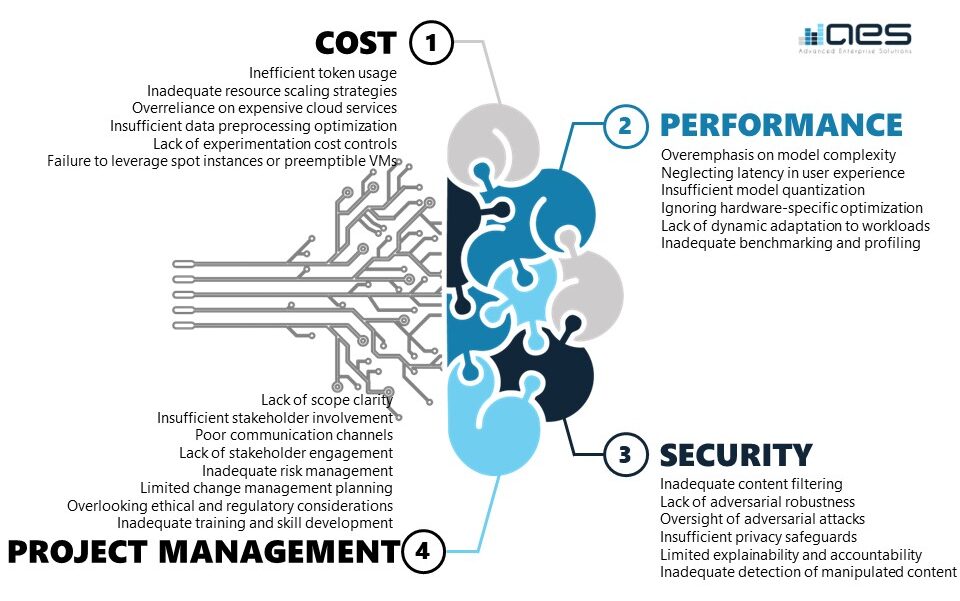In discussions with over 50 early adopters of Generative AI in the past six months, The AES Group has learned that the development of Generative AI applications is rife with pitfalls in four primary areas: cost management, performance optimization, security and project management. Recognizing these pitfalls is then crucial for businesses seeking to navigate the complex landscape of Generative AI successfully.

We’ve built our value streams and accelerators in our Generative AI Factory to proactively to address the challenges and ensure our clients fully maximize the power of Generative AI to transform their businesses. Learn more about our insights and experiences by contacting us at [email protected]
COST
Inefficient Token Usage
A prevalent mistake is the inefficient usage of tokens within the model architecture. Tokens, representing units of information processed by the model, contribute significantly to computational costs. Failing to optimize token usage can lead to excessive expenses during both training and inference. Inefficient tokenization strategies often result in higher cloud service bills and hinder the practical scalability of the application.
Inadequate Resource Scaling Strategies
Mistakes are made when developers implement inadequate resource scaling strategies. Failure to dynamically scale resources based on demand can lead to overprovisioning or under-provisioning, impacting both cost-effectiveness and application performance. Effective resource scaling involves aligning computational resources with the varying workload requirements.
Overreliance on Expensive Cloud Services
A common pitfall is the overreliance on expensive cloud services without a comprehensive understanding of pricing structures. Rushing to leverage platforms like AWS, Azure, or Google Cloud without optimizing for cost-effective services can result in unexpected and burdensome costs. Developers may overlook alternative cloud providers or pricing plans better suited to their specific needs.
Insufficient Data Preprocessing Optimization
Mistakes in data preprocessing can significantly impact costs. Inadequate optimization of data preprocessing pipelines may result in increased storage and computation requirements during training. This oversight can lead to unnecessary expenses associated with storing and processing large datasets inefficiently.
Lack of Experimentation Cost Controls
Developers often make mistakes by not implementing effective controls on experimentation costs. Iterative model development involves multiple experiments, each contributing to computational expenses. Without careful management, the cumulative cost of experimentation can exceed budgetary constraints. Implementing cost monitoring and control mechanisms during the experimentation phase is crucial for cost-effective development.
Failure to Leverage Spot Instances or Preemptible VMs
Neglecting to leverage cost-saving options such as spot instances on AWS or preemptible VMs on Google Cloud is a common mistake. These instances offer significant cost savings compared to on-demand instances, especially for tasks that can tolerate interruptions. Failing to incorporate these cost-effective options can result in missed opportunities for substantial savings.
PERFORMANCE
Overemphasis on Model Complexity
One common mistake is the overemphasis on increasing model complexity without a comprehensive understanding of the eventual impact on performance. Complex models may offer high accuracy during training but often result in impractical latency during inference. The pursuit of complexity without careful consideration of real-time requirements can lead to sluggish applications, diminishing the user experience.
Neglecting Latency in User Experience
Failing to prioritize low-latency inference is a critical mistake that affects the overall user experience. Some developers focus primarily on achieving high accuracy during model development, overlooking the importance of responsive interactions. High latency in Generative AI applications, especially in interactive scenarios, can result in frustrating delays and hinder the practical usability of the application.
Insufficient Model Quantization
Mistakes in model quantization, or the process of reducing the precision of model parameters, can impact both computational efficiency and inference speed. Some developers neglect or improperly apply quantization techniques, leading to suboptimal performance. Properly implementing quantization strategies is crucial for minimizing the computational load and achieving faster inference times.
Ignoring Hardware-specific Optimization:
Neglecting hardware-specific optimization is a notable mistake in Generative AI development. Different hardware architectures, such as GPUs and TPUs, have unique characteristics. Failing to tailor models for specific hardware can result in suboptimal performance. Optimization efforts should consider the target deployment environment to leverage hardware capabilities effectively.
Lack of Dynamic Adaptation to Workloads
A common oversight is the lack of dynamic adaptation to varying workloads. Generative AI applications may face fluctuating demand or input complexity. Failing to incorporate mechanisms for dynamic adjustment of model parameters or computational resources can lead to inefficiencies during periods of low or high demand, impacting both performance and resource utilization.
Inadequate Benchmarking and Profiling
Mistakes often occur when developers do not conduct thorough benchmarking and profiling of their models. Inadequate testing across diverse datasets and scenarios can result in suboptimal model configurations. Comprehensive benchmarking helps identify performance bottlenecks and allows for informed optimization strategies.
SECURITY
Inadequate Content Filtering
A prevalent mistake in Generative AI development is the inadequate implementation of content filtering mechanisms. Generative models can produce realistic text, images, and media, including misinformation, hate speech, and other harmful content. Traditional static content filtering approaches struggle to keep up with the dynamic nature of generated content. Failing to filter this content can lead to the spread of inappropriate or malicious material, such as deepfake applications contributing to misinformation, harassment, or identity theft. To address this issue, more sophisticated and adaptive filtering mechanisms are needed, combining automated algorithms with human moderation and oversight. Collaboration between AI researchers, industry stakeholders, and policymakers is crucial to develop best practices and guidelines for content filtering in generative AI.
Lack of Adversarial Robustness
Another common mistake is overlooking adversarial attacks. Adversarial robustness in generative AI refers to a model’s ability to maintain functionality and performance when faced with intentionally deceptive inputs. Generative models like deep neural networks, GANs, and VAEs are vulnerable to adversarial manipulations, where small changes to input data can result in significant changes in generated output. This issue is concerning because it undermines the reliability and trustworthiness of the generated content, compromising the authenticity of the application’s output.
Insufficient Privacy Safeguards
Insufficient privacy safeguards in generative AI refer to the lack of measures to protect individuals’ privacy in data training and content generation. Generative models like LLMs and GANs can memorize and reproduce sensitive information, posing privacy risks. One key mistake is the inadequate implementation of privacy safeguards during training and deployment, leading to unintended breaches and violations of data protection regulations. Addressing this issue involves implementing privacy-mitigating techniques like differential privacy, federated learning, and secure multiparty computation to ensure models don’t compromise individuals’ privacy.
Limited Explainability and Accountability
Limited explainability in generative AI occurs because these models operate as black boxes, making it hard to understand their decision-making process. This lack of transparency hinders efforts to hold generative AI systems accountable for their actions. Prioritizing model complexity over interpretability can lead to mistakes, particularly in applications with real-world implications like legal or medical domains, where explaining model decisions is crucial for accountability and trust.
Inadequate Detection of Manipulated Content
Inadequate detection of manipulated content, especially from generative AI like GANs, poses a significant challenge. This technology creates highly realistic media that can be indistinguishable from real content. This is particularly concerning for combating deepfakes. Insufficient development and deployment of content verification tools can result in the spread of AI-generated content, leading to potentially harmful consequences.
PROJECT MANAGEMENT
Lack of Scope Clarity
A common mistake is the absence of a clear project scope. Generative AI applications often involve complex tasks, and without a well-defined scope, projects can become sprawling and unmanageable. Lack of clarity on project objectives, deliverables, and milestones can lead to delays, scope creep, and misalignment of expectations.
Insufficient Stakeholder Involvement
Mistakes are made when project teams do not involve key stakeholders adequately. Generative AI applications often impact various stakeholders, including domain experts, end-users, and business leaders. Failure to incorporate their insights and requirements can result in solutions that do not align with organizational goals or user needs.
Poor Communication Channels
Ineffective communication channels can hinder project progress. Mistakes often occur when project teams fail to establish clear and transparent communication lines. Lack of regular updates, feedback loops, and collaboration mechanisms can lead to misunderstandings, delays in decision-making, and a lack of alignment among team members.
Inadequate Risk Management
Generative AI projects often involve inherent uncertainties and risks. Mistakes are made when project teams do not conduct thorough risk assessments and mitigation planning. Unexpected challenges, such as data quality issues or model performance limitations, can derail projects if not identified and addressed proactively.
Limited Change Management Planning
Change management is critical in the deployment of Generative AI applications. A mistake often made is the limited focus on change management planning. Introducing AI-driven solutions may necessitate changes in workflows, roles, or organizational processes. Without a robust change management strategy, resistance to these changes may impede successful deployment.
Overlooking Ethical and Regulatory Considerations
Failing to integrate ethical and regulatory considerations is a significant mistake. Generative AI applications, especially those involving sensitive data or content generation, require adherence to ethical guidelines and regulatory frameworks. Neglecting these considerations can result in legal challenges, reputational damage, and user distrust.
Inadequate Training and Skill Development
Mistakes in project management include insufficient investment in training and skill development. Generative AI development often requires specialized knowledge in machine learning and data science. Failure to upskill team members or provide necessary training can hinder project progress and compromise the quality of the developed solutions.
